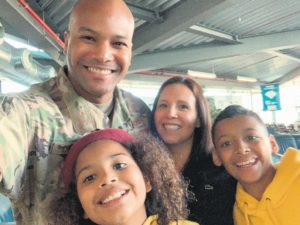
Every Airman’s deployment experience is different. For some, deployments are exhilarating, while for others they can be stressful and traumatic.
For Tech. Sgt. Graeme Clouden, an electrician with the 786th Civil Engineer Squadron, it’s been a mix of excitement and distress. Having been deployed five times over the course of 16 years, only one of his deployments stands out in his mind. In 2014, he deployed to Afghanistan with the 1st Expeditionary Civil Engineer Group, where he was immersed in a hectic, uncontrollable environment, experiencing regular attacks, including one within 24 hours of his arrival.
Attacks on base became so regular”that over time some Airmen didn’t even respond to the warnings. One evening during dinner Clouden heard the usual warning call “Incoming” boom over the speakers. Like most Airmen he took cover, while a few others remained in their seats continuing to eat as if it was a regular day.
That moment remains with Clouden. “I remember feeling worried, nervous and aware that at any moment, a blast could destroy the base. I also remember the disturbing feeling it gave me to realize the mindset my peers must have had to not react when their lives were in such imminent danger,” he said.
During the same deployment, Clouden recalls another shocking experience, “During that deployment, one of my jobs was to put up a fence on the base. We usually worked from the morning until lunch, but one day, since we were ahead of schedule, we decided to end early. When we returned, we found the section of the fence blown up. Had we not been ahead of schedule, who knows what kind of injuries could have happened.”
Out there everything around him was fragile, including himself, which required a more strenuous mindset to get through each day, surrendering to the idea that, at any moment, a single attack could change everything. Even now, more than five years later, he still remembers those two upsetting events in detail.
When Clouden returned home, at Aviano Air Base, Italy, he was numb and emotionless. He struggled to process information, experienced memory loss, and was absent-minded. Adjusting back to his home and work life was challenging, and he found himself irritable, angry and upset over small things. Coworkers avoided him, and his wife and kids walked on eggshells around him. To cope, Clouden found he had unlimited access to alcohol and started abusing it. Daily he would come home after work with multiple bottles of liquor.
One day, after exploding in frustration at his optometrist because of an appointment miscommunication, he finally knew he needed help. “I blew up and just lost it. That’s when I realized I wasn’t okay. I didn’t want to be a statistic, just another Airman who came back damaged, but I wanted to be happy and that [incident] made me realize I needed and wanted to get help,” recalls Clouden.
Not knowing where to start, Clouden made an appointment at the Mental Health Clinic. “I felt awkward asking for an appointment, telling a stranger that I was angry all the time and thought I was depressed,” says Clouden. “But it changed my life forever. It saved me.”
Initially, the clinic connected him with a civilian counselor on base, who he met with weekly for talk therapy sessions. “We really connected. From the start, I felt safe talking to her,” he recalls.
After the sessions came to a close, since the therapy had helped, he decided to continue therapy with a military counselor who diagnosed him with anxiety, depression and Attention-Deficit/Hyperactivity Disorder, and prescribed medication for these invisible wounds.
Clouden is grateful he sought support from the mental health professionals, which assisted him in maintaining his career progression. For him, therapy was the game changer, providing him clarity and teaching him self-reflection techniques and methods for managing emotions in a healthy way.
“The therapy helped me feel normal again. It helped me focus and look at things differently, helping me to understand why I did a lot of things. I wasn’t suicidal, but was obviously depressed,” said Clouden.
Now recovered, and continuing to progress in his career, he communicates better with others and regularly practices self-reflection. He still carries his invisible wounds story with him as a reminder of who he wants to be — a loving father and husband and the best Airman he can be.
Like Clouden, many Airmen are living with invisible wounds. In fact, all Airmen are susceptible to invisible wounds, regardless of career field. Invisible wounds can be caused by any type of traumatic experience, including combat exposure, blow to the head, physical abuse, sexual assault, blast exposure, serious accidents, death of a loved one or emotional abuse.
Invisible wounds have real-life impacts on both personal and professional lives and, if left untreated, the effects could worsen until assistance is provided. If you or a fellow Wingman is living with invisible wounds, encourage them to connect to resources to enable their journey to recovery and resiliency.
For Airmen struggling with invisible wounds, Clouden offers the following advice: “It’s not easy, but I encourage you to take that first step in seeking help. Talk to someone about what’s going on. Don’t keep putting it off.”
The Invisible Wounds Initiative mission is to improve the quality and value of support provided to Airmen with invisible wounds, to improve the perception of invisible wounds and to remove barriers of care, to ensure Airmen with invisible wounds are treated fairly, equally and in accordance with the Air Force’s commitment to Airmen and their families and to ensure continuum of care processes are executed effectively and efficiently.
For more information about IWI, visit https://www.woundedwarrior.af.mil/Airmen-Veterans/Invisible-Wounds-Initiative.


